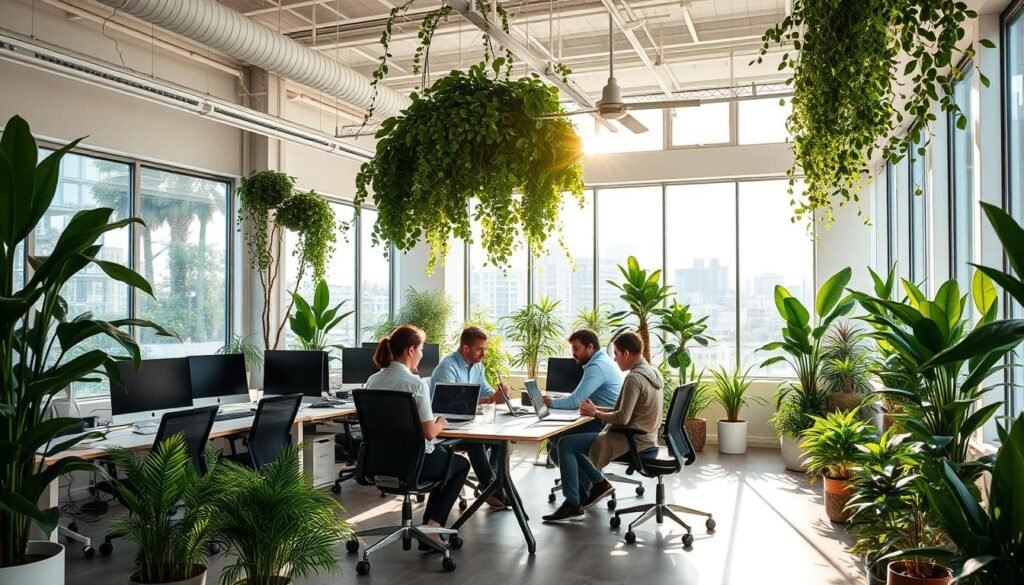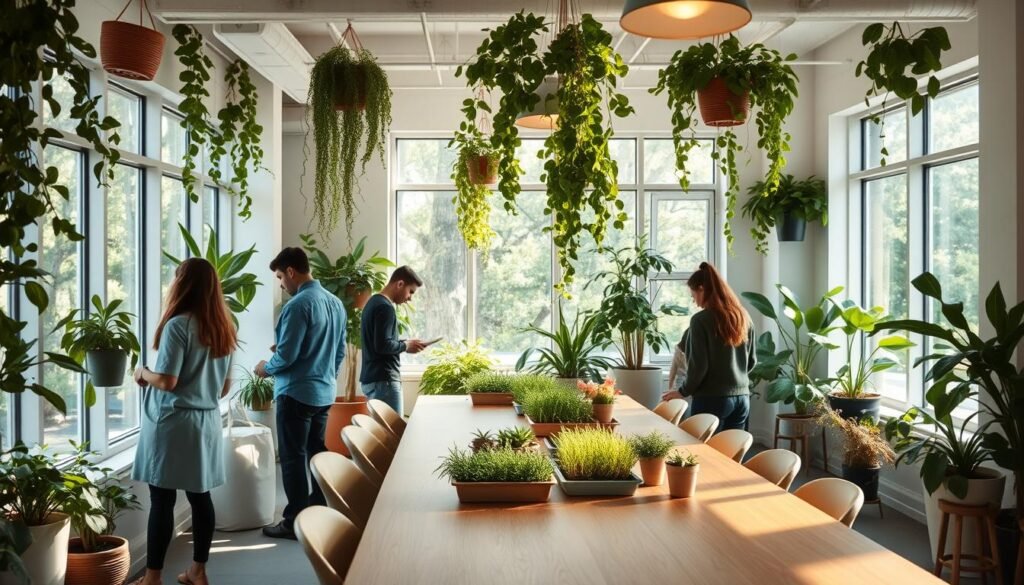Welcome to your complete guide on creating a workspace that benefits both your health and our planet. Your office environment plays a crucial role in your daily work experience and overall well-being.
You’ll discover practical steps to transform your space into a sustainable environment. These changes can lead to significant reductions in energy consumption and waste production.
We’ll explore how thoughtful design choices not only help the environment but also boost your productivity. The strategies we share are budget-friendly and easy to implement today.
By following this guide, you’ll create a workspace that aligns with modern sustainability standards. Let’s begin this journey toward making a positive impact through smarter office design.
Key Takeaways
- Creating a sustainable workspace benefits both personal health and environmental protection
- Simple changes can significantly reduce energy consumption and waste
- Eco-friendly design choices can improve productivity and overall well-being
- Many sustainable solutions are budget-friendly and easy to implement
- Modern offices can align with environmental standards without sacrificing functionality
- Thoughtful design creates a positive impact on both people and the planet
Understanding the Importance of Sustainable Office Design
Your choice of office design extends far beyond aesthetics, creating ripple effects that impact both your team and the natural world. Thoughtful planning in your professional environment delivers remarkable advantages that many businesses overlook.
The Environmental Impact of Traditional Workspaces
Conventional office setups carry a heavy environmental burden. According to World Resources Institute data, offices account for nearly 20% of all commercial energy consumption.
Buildings contribute approximately 40% of global CO2 emissions. This significant carbon footprint accelerates climate change through excessive energy use and resource waste.
Traditional workspaces often feature:
- High electricity consumption from outdated systems
- Substantial material waste from disposable products
- Poor insulation leading to energy loss
- Limited natural light requiring artificial alternatives
These practices create an unsustainable pattern that demands immediate attention and innovative solutions.
Business Benefits of Going Green in Your Office
Adopting sustainable practices transforms your operational efficiency and financial performance. LEED certifications can increase property values while reducing operational costs by up to 19%.
Your company gains competitive advantages through green initiatives:
- Reduced utility expenses through energy-efficient systems
- Enhanced brand reputation among environmentally conscious consumers
- Attraction of top talent who value corporate responsibility
- Long-term savings from durable, sustainable materials
“Sustainable design isn’t an expense—it’s an investment that pays dividends in operational efficiency and brand equity.”
These benefits create a compelling business case for embracing environmental responsibility in your workspace.
How Eco-Friendly Design Boosts Employee Well-being
Your team’s health and satisfaction directly connect to their physical environment. Sustainable designs promote wellness through improved air quality, natural lighting, and ergonomic considerations.
Employees in green offices experience:
- Fewer sick days due to better ventilation and non-toxic materials
- Higher job satisfaction from working in pleasant, health-conscious spaces
- Increased productivity through comfortable temperature control and lighting
- Reduced stress from connection to natural elements and outdoor views
This positive impact on well-being translates to better retention rates and stronger team performance. Your investment in sustainable design pays returns through happier, more engaged employees.
Small changes in your office setup create meaningful improvements in both environmental impact and workplace culture. The journey toward sustainability begins with understanding these interconnected benefits.
Optimizing Your Office Space for Sustainability
Transforming your professional environment starts with smart space utilization. You can dramatically reduce environmental impact while enhancing functionality through strategic planning.

Many businesses operate with excess square footage that drains energy and budget. The right approach balances your actual needs with environmental responsibility.
Right-Sizing Your Workspace Footprint
Evaluating your actual spatial requirements creates immediate sustainability benefits. Downsizing to match your team’s size eliminates energy waste in unused areas.
This approach reduces your carbon footprint significantly. Smaller spaces require less heating, cooling, and lighting.
Consider these advantages:
- Lower utility costs from reduced energy consumption
- Decreased maintenance expenses for cleaning and repairs
- Higher space utilization efficiency throughout your workday
- Reduced environmental impact through smarter resource allocation
Incorporating Multifunctional Areas
Modern offices thrive on flexibility through multifunctional zones. These adaptable spaces serve multiple purposes without compromising functionality.
Products like QUBIC pods transform from individual workstations to meeting rooms. This versatility maximizes your investment while minimizing spatial requirements.
You gain several benefits:
- Enhanced collaboration through configurable work environments
- Reduced furniture needs with dual-purpose installations
- Improved team productivity through purpose-built areas
- Better space management without constant reconfiguration
Considering Coworking Space Alternatives
Shared work environments present compelling sustainability advantages. Coworking spaces distribute resource consumption among multiple businesses.
This model reduces individual environmental impact through shared facilities. You access premium amenities without maintaining them exclusively.
The advantages include:
- Shared resource utilization cutting overall consumption
- Reduced overhead costs through communal infrastructure
- Flexible membership options matching your actual usage
- Networking opportunities within collaborative environments
“The most sustainable space is the one you actually use efficiently—every unused square foot represents wasted energy and missed opportunities.”
Implementing these strategies creates a leaner, more adaptable professional environment. Your space becomes both economically and environmentally efficient.
These changes support modern work trends while reducing your ecological footprint. You create a workspace that truly works for your team and the planet.
How to Design Eco-Friendly Workspaces with Smart Lighting Solutions
Lighting transforms your workspace more than you might realize, affecting both energy bills and team morale. The right approach creates a brighter environment while cutting costs significantly.
These strategies deliver immediate results for your bottom line and carbon footprint. You’ll notice improvements in atmosphere and efficiency from day one.
Maximizing Natural Light Benefits
Daylight offers free illumination that boosts mood and productivity simultaneously. Positioning workstations near windows creates natural advantages.
Your team enjoys better visual comfort and reduced eye strain. Studies show exposure to natural light improves sleep patterns and overall well-being.
Consider these layout adjustments:
- Place desks perpendicular to windows for optimal light distribution
- Use light-colored walls to reflect daylight deeper into your space
- Install skylights in interior areas where windows aren’t feasible
- Choose low-partition furniture that doesn’t block light flow
These changes reduce reliance on artificial sources during daylight hours. You save on electricity while creating a more inviting atmosphere.
Switching to Energy-Efficient LED Lighting
LED technology revolutionized illumination with remarkable efficiency gains. These bulbs use up to 75% less power than traditional options.
You benefit from longer lifespan and reduced maintenance costs. LEDs last years longer than incandescent or fluorescent alternatives.
The advantages extend beyond simple energy savings:
- Superior light quality with better color rendering
- Minimal heat output reducing cooling needs in summer months
- Instant full brightness without warm-up time
- Dimmable options for customized illumination levels
This upgrade pays for itself through lower utility bills and replacement costs. Your space gains modern, comfortable lighting that serves everyone better.
Implementing Motion-Activated Lighting Systems
Smart sensors eliminate wasted electricity in unused areas. These devices automatically illuminate spaces only when needed.
You prevent lights from burning empty rooms all day long. This simple technology makes a substantial impact on overall consumption.
Focus installation on these key areas first:
- Storage rooms and supply closets
- Restrooms and break areas
- Conference rooms between meetings
- Hallways and transitional spaces
“Intelligent lighting controls represent the easiest win for immediate energy reduction—often cutting usage by 30-40% in underutilized spaces.”
These systems require minimal investment but deliver maximum returns. You create a responsive environment that adapts to actual usage patterns.
Combining these approaches creates comprehensive lighting solutions for modern office spaces. You achieve significant energy reduction while enhancing workplace quality and comfort.
Selecting Sustainable Materials and Furniture
Your material choices create lasting impacts on both your workspace and the planet. Thoughtful selection transforms your professional environment while supporting ecological balance.
Every purchase decision represents an opportunity for positive change. You build a healthier space while reducing environmental strain through smart choices.
Choosing Recycled and Renewable Materials
Recycled content gives new life to existing resources without additional extraction. These materials often match virgin products in quality and durability.
You contribute to a circular economy while reducing landfill waste. Many recycled options cost less than their newly manufactured counterparts.
Excellent choices include:
- Recycled steel for structural elements and furniture frames
- Reclaimed wood for desks and decorative features
- Recycled plastic for chairs and storage solutions
- Recycled glass for countertops and partition walls
Investing in Energy-Efficient Office Furniture
Quality furniture lasts longer and requires fewer replacements over time. Modular pieces adapt to changing needs without complete overhauls.
You conserve resources through durable, adaptable solutions. These investments pay back through reduced maintenance and replacement costs.
Look for these features:
- Modular designs that reconfigure for different uses
- Non-toxic finishes that protect indoor air quality
- Durable construction that withstands daily use
- Standardized components for easy repairs and updates
Opting for Bamboo, Cork, and Other Eco-Friendly Options
Natural materials bring warmth and sustainability to your professional space. Bamboo grows rapidly, making it highly renewable.
Cork harvesting doesn’t harm trees, allowing continuous regeneration. Both materials offer unique aesthetic appeal and practical benefits.
These options provide:
- Natural antimicrobial properties for healthier surfaces
- Excellent durability for long-term performance
- Renewable sourcing that protects natural resources
- Unique textures that enhance visual appeal
“The most sustainable product is the one you never need to replace—durability becomes environmental responsibility.”
Certifications help identify truly sustainable products. Look for GREENGUARD, FSC, or Cradle to Cradle labels when selecting materials.
Your choices create a workspace that reflects modern values while protecting our shared environment. These decisions benefit your team, your budget, and our planet.
Implementing Energy and Resource Conservation Systems
Conservation systems transform how your business consumes vital resources every day. These smart solutions reduce waste while maintaining comfort and productivity.
You’ll discover practical approaches that cut costs and environmental impact simultaneously. Modern technology makes implementation easier than ever before.
Smart Climate Control Strategies
Programmable thermostats optimize your heating and cooling patterns automatically. These devices learn your schedule and adjust temperatures when spaces are unoccupied.
Smart climate systems can reduce energy use by up to 10%. They prevent wasted consumption during nights and weekends.
Consider these advantages:
- Automated temperature adjustments based on occupancy patterns
- Remote control capabilities through mobile applications
- Energy usage reports that help identify waste patterns
- Integration with other smart office systems for maximum efficiency
Energy-Efficient Device Management
Smart power strips eliminate phantom energy drain from electronics. These devices cut power to peripherals when main devices shut down.
You prevent energy consumption from idle computers and monitors. This simple change creates immediate savings on your electricity bill.
Effective management includes:
- Energy-star rated equipment throughout your office
- Automated shutdown schedules for non-essential devices
- Power management settings on all computers and monitors
- Regular energy audits to identify consumption patterns
Water Conservation Techniques
Low-flow fixtures reduce water usage without sacrificing performance. These installations lower utility costs and environmental impact significantly.
Your business can cut water consumption by 30% or more. This reduction benefits both your budget and local water resources.
Effective techniques include:
- Aerated faucets that maintain pressure while reducing flow
- Dual-flush toilets that offer appropriate water volumes
- Sensor-activated fixtures that prevent accidental left-on running
- Regular leak detection and maintenance programs
“The most effective conservation systems work silently in the background, creating savings without compromising comfort or functionality.”
These strategies reduce your carbon footprint while creating healthier environments. They represent smart investments that pay returns through lower operational costs.
Your team will appreciate the improved air quality and comfort levels. These changes demonstrate your commitment to responsible business practices.
Creating a Green Office Culture and Practices
The true transformation of your workspace happens when daily habits align with ecological values throughout your organization. This cultural shift turns individual actions into collective impact that benefits both your business and the planet.
Your team’s commitment to sustainable practices creates lasting change beyond physical renovations. These behavioral adjustments often deliver the most significant environmental benefits over time.

Reducing Single-Use Plastics and Waste
Eliminating disposable items represents one of the easiest wins for your office environment. Simple swaps create immediate reductions in landfill contributions.
Start by replacing plastic utensils with compostable alternatives or reusable metal options. Provide ceramic mugs instead of disposable cups for coffee breaks.
Consider these effective strategies:
- Install water filtration systems to eliminate bottled water purchases
- Switch to bulk condiment dispensers instead of individual packets
- Offer reusable food containers for team lunches and leftovers
- Choose supplies with minimal packaging from environmentally conscious suppliers
These changes reduce waste while demonstrating your commitment to sustainable practices. Your team will appreciate the thoughtful approach to everyday items.
Establishing Effective Recycling Programs
Proper recycling systems turn would-be waste into valuable resources. Clear guidelines prevent contamination that renders materials unrecyclable.
Place color-coded bins throughout your space with simple visual instructions. Educate your employees about what goes where through regular training sessions.
Successful programs typically include:
- Separate streams for paper, plastic, glass, and metal
- Clearly labeled containers with examples of acceptable items
- Regular audits to identify and address contamination issues
- Partnerships with reliable recycling services that process materials properly
“The most effective recycling programs make proper disposal easier than throwing things away—convenience drives participation.”
Your investment in education pays off through higher participation rates and cleaner streams. This approach maximizes the environmental benefits of your recycling efforts.
Encouraging Digital Documentation Over Printing
Transitioning to digital workflows significantly reduces paper consumption in your office. The paper industry produced 411 million metric tons in 2016, representing substantial environmental impact.
Cloud-based systems and digital signatures eliminate need for physical copies. Encourage your team to think digitally before reaching for the printer.
Implement these paper-reduction strategies:
- Default double-sided printing for essential documents
- Digital meeting agendas and note-taking systems
- Electronic filing systems with robust search capabilities
- Training on digital collaboration tools that reduce printing needs
These practices not only conserve resources but also improve organizational efficiency. Your team benefits from faster access to information while reducing environmental impact.
Building a green culture requires consistent reinforcement of these values. Celebrate successes and share progress to maintain engagement across your organization.
Conclusion: Building Your Sustainable Workspace Future
Your journey toward a healthier professional environment begins with actionable steps. You now possess practical solutions to transform your office space.
Small changes create significant benefits over time. Your efforts reduce energy use and boost team productivity simultaneously.
Every sustainable choice makes a difference. Start implementing these strategies in your work space today.
Your commitment shapes a greener future. Share successes to inspire others on this meaningful way forward.





